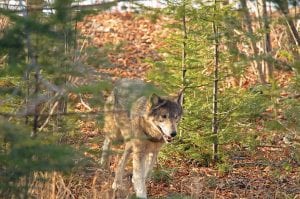On May 28, 2013, the Minnesota Court of Appeals denied a challenge by the Center for Biodiversity and Howling for Wolves who argued that the Minnesota Department of Natural Resources (DNR) failed to give ample opportunity for public comment before introducing a wolf season in Minnesota. The higher court did not agree, paving the way for another wolf hunt.
In its arguments, the DNR said it received direction from the Legislature that it should organize a wolf hunt last fall. To meet the legislative directive, the DNR did not publish a proposed rule, which would entail public meetings and written comments. Instead the DNR posted an online survey to gauge public opinion about such questions as how long the season should last and how hunters and trappers should be notified when the target was reached.
More than 7,000 people responded to the survey, many of them from outside Minnesota. Nearly 80 percent of respondents said they didn’t want to see a wolf hunt at all. The DNR maintains opponents of a wolf hunt conducted a campaign to skew the results.
Of the decision, DNR Commissioner Tom Landwehr said, “This decision affirms that the DNR, as directed by the Legislature, set the correct and proper course in establishing last year’s wolf season. Furthermore, the recent Legislature clarified the rulemaking process for setting future seasons, affirming the DNR is using the correct season setting process.”
The DNR used the same rulemaking process for the wolf season as it does for dozens of other game species. DNR spokesman Chris Niskanen told MPR that there was plenty of opportunity for public comment during the legislative hearings that led to the season.
Commissioner Landwehr said the DNR is committed to the long-term sustainability of the state’s wolf population, the largest in the lower 48 states, and the agency took a conservative approach to the inaugural season. The DNR sold 3,600 permits for the early-season hunt and 2,400 permits for the late season.
When the first-ever wolf season was initiated, the DNR believed that Minnesota had a population of about 3,000 wolves, and the season would not have any significant impact on the population. The first wolf season completely closed at the end of shooting and trapping hours on Jan. 3, 2013. The number of wolves killed in the early and late season hunting and trapping seasons was 395.
When the season closed, Dan Stark, large carnivore specialist for DNR, said, “Our plan was to close the season when the harvest was at or projected to reach 400.”
Plans are under way for a 2013 wolf season. The DNR will set the season this summer after analyzing data from the previous season and a wolf population estimate is completed.
According to a news release from the Center for Biological Diversity, conservation groups are considering their next steps, which may include an appeal to the Minnesota Supreme Court.
“It is hard to put into words our disappointment and sense of injustice,” said Maureen Hackett, president of Howling for Wolves. “The public has a legitimate concern in the care and management of the Minnesota wolf and all our natural resources. Although today’s decision is a setback, we will continue our fight to protect Minnesota’s wolves.”
The wolf is sacred to Minnesota Ojibwe and no hunting or trapping has been or will be allowed on native lands.
Visit the DNR website www.dnr. state.mn.us/mammals/wolves/mgmt. html.



Loading Comments